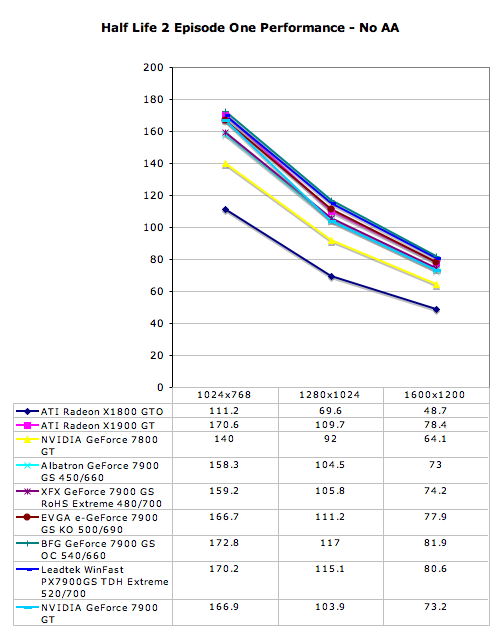The NVIDIA GeForce 7900 GS: A Closer Look
by Josh Venning on September 19, 2006 5:00 AM EST- Posted in
- GPUs
Half-Life 2: Episode One
Half-Life 2: Episode One is another standard game benchmark we use to test our GPUs. The engine has been around for a while, but Valve has been adding things like bloom and HDR effects to give the graphics new life. One thing we like about HL2:E1 is that it gets very good framerates across a wide range of cards, which isn't very common among games of this caliber. For testing we set the detail settings to "high" in the graphics settings for this game. Water detail is set to "Reflect All," and High Dynamic Range is set to "Full (if available)."


Here we again see a significant increase in performance between the Albatron 7900 GS and the BFG and Leadtek cards. We can also compare the performance of the X1900 GT and the different 7900 GS cards and see again how the two fastest 7900 GS cards perform slightly better than the X1900 GT. We can also see that there isn't much difference in performance at all between the 7900 GT and the reference clocked Albatron 7900 GS, which is further evidence that the 7900 GS could be considered the better value card of the two, depending on price.
Half-Life 2: Episode One is another standard game benchmark we use to test our GPUs. The engine has been around for a while, but Valve has been adding things like bloom and HDR effects to give the graphics new life. One thing we like about HL2:E1 is that it gets very good framerates across a wide range of cards, which isn't very common among games of this caliber. For testing we set the detail settings to "high" in the graphics settings for this game. Water detail is set to "Reflect All," and High Dynamic Range is set to "Full (if available)."


Here we again see a significant increase in performance between the Albatron 7900 GS and the BFG and Leadtek cards. We can also compare the performance of the X1900 GT and the different 7900 GS cards and see again how the two fastest 7900 GS cards perform slightly better than the X1900 GT. We can also see that there isn't much difference in performance at all between the 7900 GT and the reference clocked Albatron 7900 GS, which is further evidence that the 7900 GS could be considered the better value card of the two, depending on price.










42 Comments
View All Comments
Josh Venning - Tuesday, September 19, 2006 - link
Thanks for the comment. We didn't include FSAA tests in this article because it isn't a full analysis of 7900 GS performance, but a comparison between different 7900 GS products. For an in-depth look at the 7900 GS performance in more games and settings take a look at the 7900 GS launch coverage(http://www.anandtech.com/video/showdoc.aspx?i=2827...">http://www.anandtech.com/video/showdoc.aspx?i=2827..., and the 7950 GT article which has some 7900 GS SLI numbers (http://www.anandtech.com/video/showdoc.aspx?i=2833...">http://www.anandtech.com/video/showdoc.aspx?i=2833....As far as driver settings, we test with default driver settings with the exception of vsync which is disabled. We do the same with ATI hardware; we leave catalyst AI on its default setting. We find this is the best way to keep our tests consistent for an article like this.
giantpandaman2 - Tuesday, September 19, 2006 - link
I wonder if part of the difference in heat/power consumption had to do with how much power was supplied to the fans. Slow running fan=low power=high heat. Faster fan=higher power=low heat.Meh, I'm not sure a tiny fan could ever put a dent in a 20 watt difference though.